A stack is an abstract data type (ADT) which is used to store data in a linear fashion. A stack only has a single end (which is stack’s top) through which we can insert or delete data from it.
There are many different stack operations which can be applied on a stack. We will discuss most of the operations in this article.
Scope
- This article briefly defines what is a stack and why it is used.
- Various stack operations applicable on a stack are discussed in this article along with their syntax representation.
- The syntax discussed in this article will be only for C++ programming language.
Takeaways
Operations in stack:
push(), pop(), peek(), isEmpty(), isFull(), size()
Introduction to Stack
A stack is a data structure which is used to store data in a linear fashion. It is an Abstract data type (ADT) in which data is inserted and deleted from a single end which is the stack's top. It follows a Last in, First out (LIFO) principle i.e. the data which is inserted most recently in the stack will be deleted first from the stack.
Given below is the pictorial representation of how a stack looks like.
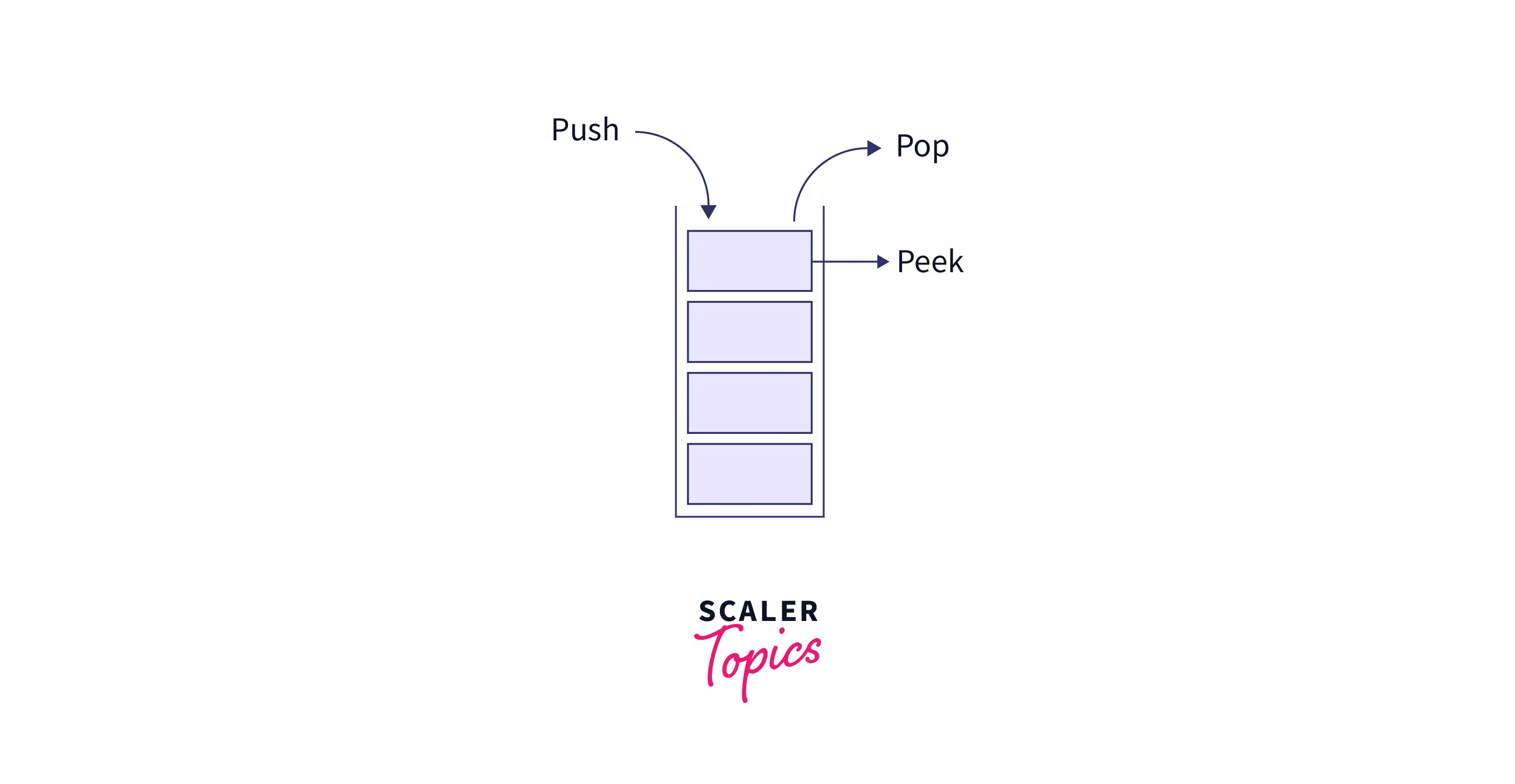
We also have a separate article where the stack data structure is discussed in detail: Stacks in Data Structure.
Stack Representation
A stack follows a Last in, First out principle (LIFO). This means the data inserted in the stack last will be first to be removed. Also, the data is inserted or deleted through the stack top.
Given below is the stack representation to show how data is inserted and deleted in a stack.

Stack Operations
There are various stack operations that are applicable on a stack. Stack operations are generally used to extract information and data from a stack data structure.
Some of the stack operations are given below.
1. push()
Push is a function in stack definition which is used to insert data at the stack’s top.
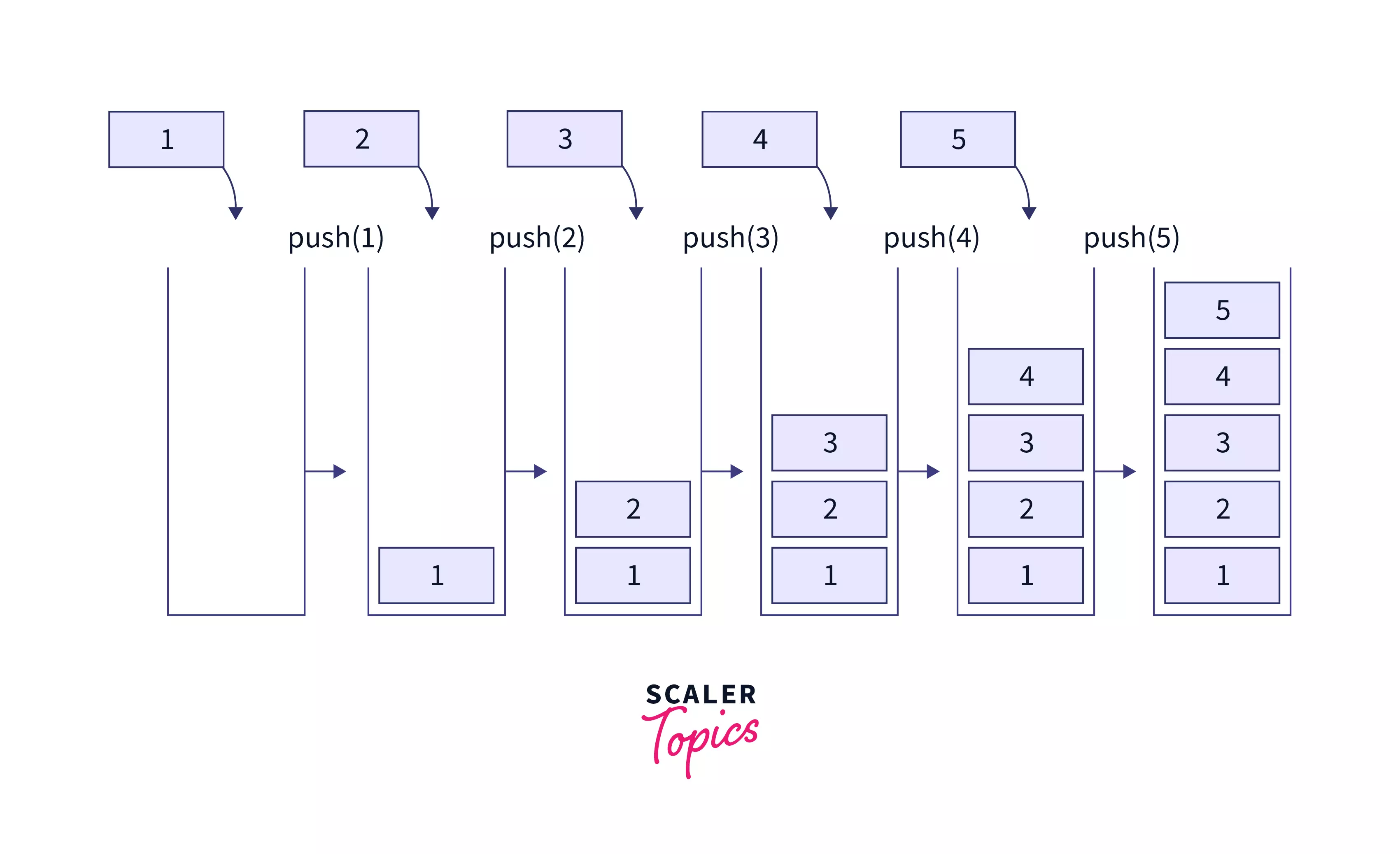
Given below is the syntax of the push function in the stack.
#include<bits/stdc++.h>
using namespace std;
int main(){
stack<int> s; // creating a stack of integers
s.push(1); // This pushes 1 to the stack top
s.push(2); // This pushes 2 to the stack top
s.push(3); // This pushes 3 to the stack top
s.push(4); // This pushes 4 to the stack top
s.push(5); // This pushes 5 to the stack top
// printing the stack
while(!s.empty())
{
cout<<s.top()<<" ";
s.pop();
}
// The above loop prints "5 4 3 2 1"
// Now, let us remove elements from the stack using pop function
s.pop(); // removes 5 from the stack since 5 was present at the top. Now, the new stack top becomes 4.
s.pop(); // removes 4 from the stack since 4 was present at the top. Now, the new stack top becomes 3.
s.pop(); // removes 3 from the stack since 3 was present at the top. Now, the new stack top becomes 2.
s.pop(); // removes 2 from the stack since 2 was present at the top. Now, the new stack top becomes 1.
s.pop(); // removes 1 from the stack since 1 was present at the top. Now, the stack becomes empty.
}
3. topElement() / peek()
TopElement / Peek is a function in the stack which is used to extract the element present at the stack top.
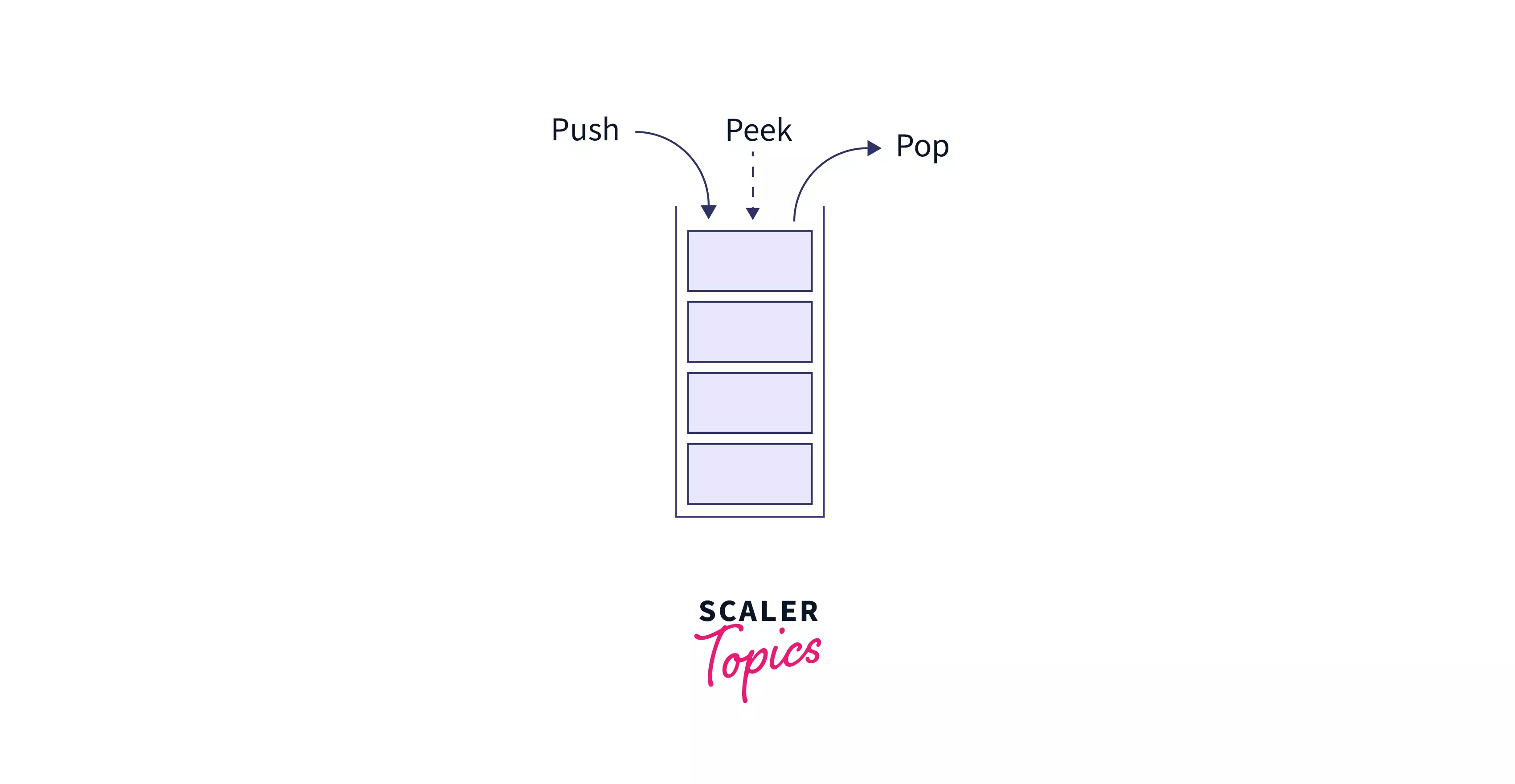
In C++, we use the top()function to extract the element present at the stack’s top. Given below is the syntax of the top function in the stack.
#include<bits/stdc++.h>
using namespace std;
int topElement(stack<int> &s)
{
return s.top();
}
int main(){
stack<int> s; // creating a stack of integers
s.push(1); // This pushes 1 to the stack top
cout<<topElement(s)<<endl; // Prints 1 since 1 is present at the stack top
s.push(2); // This pushes 2 to the stack top
cout<<topElement(s)<<endl; // Prints 2 since 2 is present at the stack top
s.push(3); // This pushes 3 to the stack top
cout<<topElement(s)<<endl; // Prints 3 since 3 is present at the stack top
}
4. isEmpty()
isEmpty is a boolean function in stack definition which is used to check whether the stack is empty or not. It returns true if the stack is empty. Otherwise, it returns false.
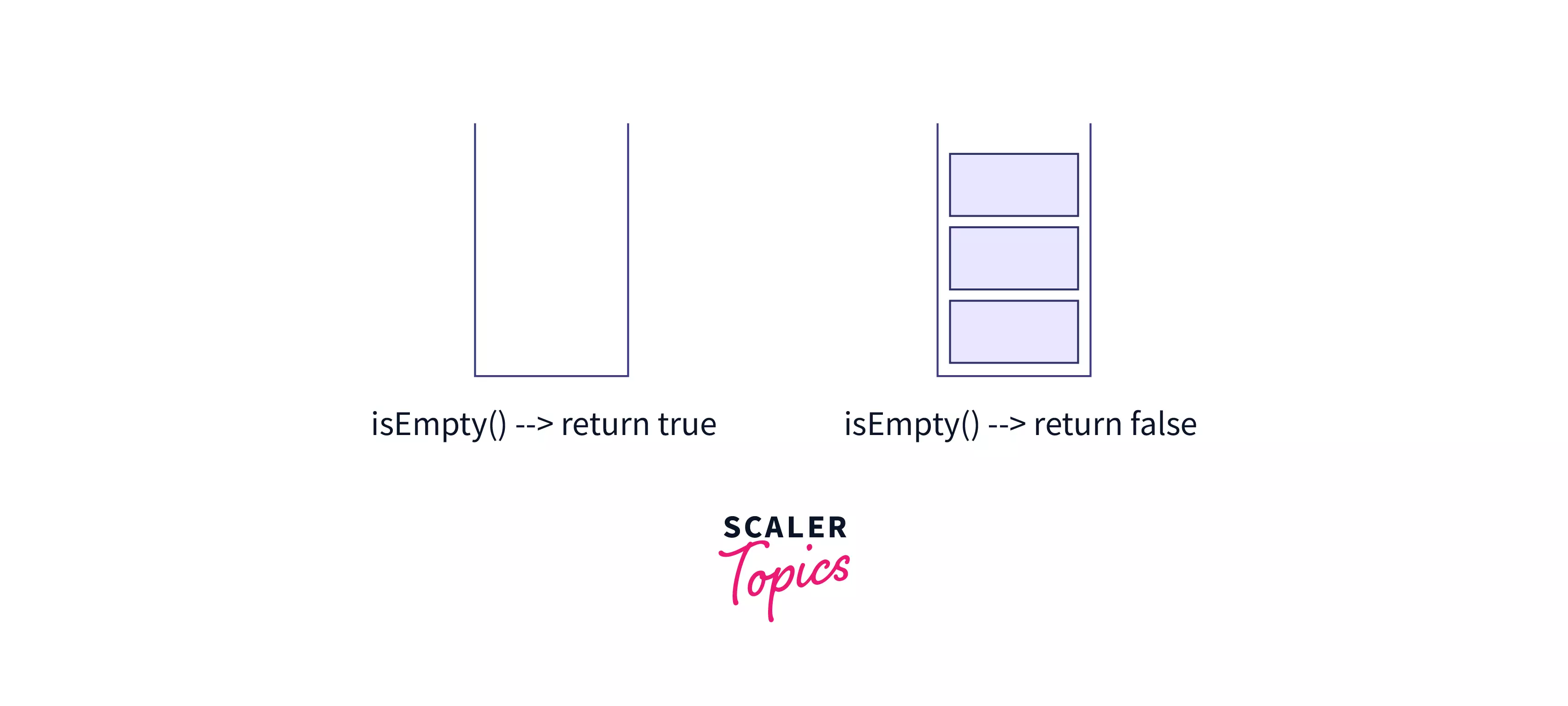
#include<bits/stdc++.h>
using namespace std;
bool isEmpty(stack<int> &s){
bool isStackEmpty = s.empty(); // checking whether stack is empty or not and storing it into isStackEmpty variable
return isStackEmpty; // returning bool value stored in isStackEmpty
}
int main(){
stack<int> s;
// The if - else conditional statements below prints "Stack is empty."
if(isEmpty(s))
{
cout<<"Stack is empty."<<endl;
}
else{
cout<<"Stack is not empty."<<endl;
}
s.push(1); // Inserting value 1 to the stack top
// The if - else conditional statements below prints "Stack is not empty."
if(isEmpty(s))
{
cout<<"Stack is empty."<<endl;
}
else{
cout<<"Stack is not empty."<<endl;
}
}
5. isFull()
isFull is a function which is used to check whether the stack has reached its maximum limit of insertion of data or not i.e. if ‘maxLimit’ is the maximum number of elements that can be stored in the stack and if there are exactly maxLimit number of elements present in the stack currently, then the function isFull() returns true. Otherwise, if the number of elements present in the stack currently are less than ‘maxLimit’, then isFull() returns false.
Given below is the syntax for the isFull function in the stack.
#include<bits/stdc++.h>
using namespace std;
int maxLimit = 3;
bool isFull(stack<int> &s)
{
if(s.size() == maxLimit)
{
return true; // returns true if s.size() == maxLimit
}
return false; // returns false if s.size() != maxLimit
}
int main(){
stack<int> s;
s.push(1); // Inserting 1 in the stack
s.push(2); // Inserting 2 in the stack
// The below if - else statement prints "Stack is not full."
if(isFull(s))
{
cout<<"Stack is full."<<endl;
}
else{
cout<<"Stack is not full."<<endl;
}
s.push(3); // Inserting 3 in the stack
// The below if - else statement prints "Stack is full."
if(isFull(s))
{
cout<<"Stack is full."<<endl;
}
else{
cout<<"stack is not full."<<endl;
}
}
6. size()
Size is a function in stack defintion which is used to find out the number of elements that are present inside the stack.
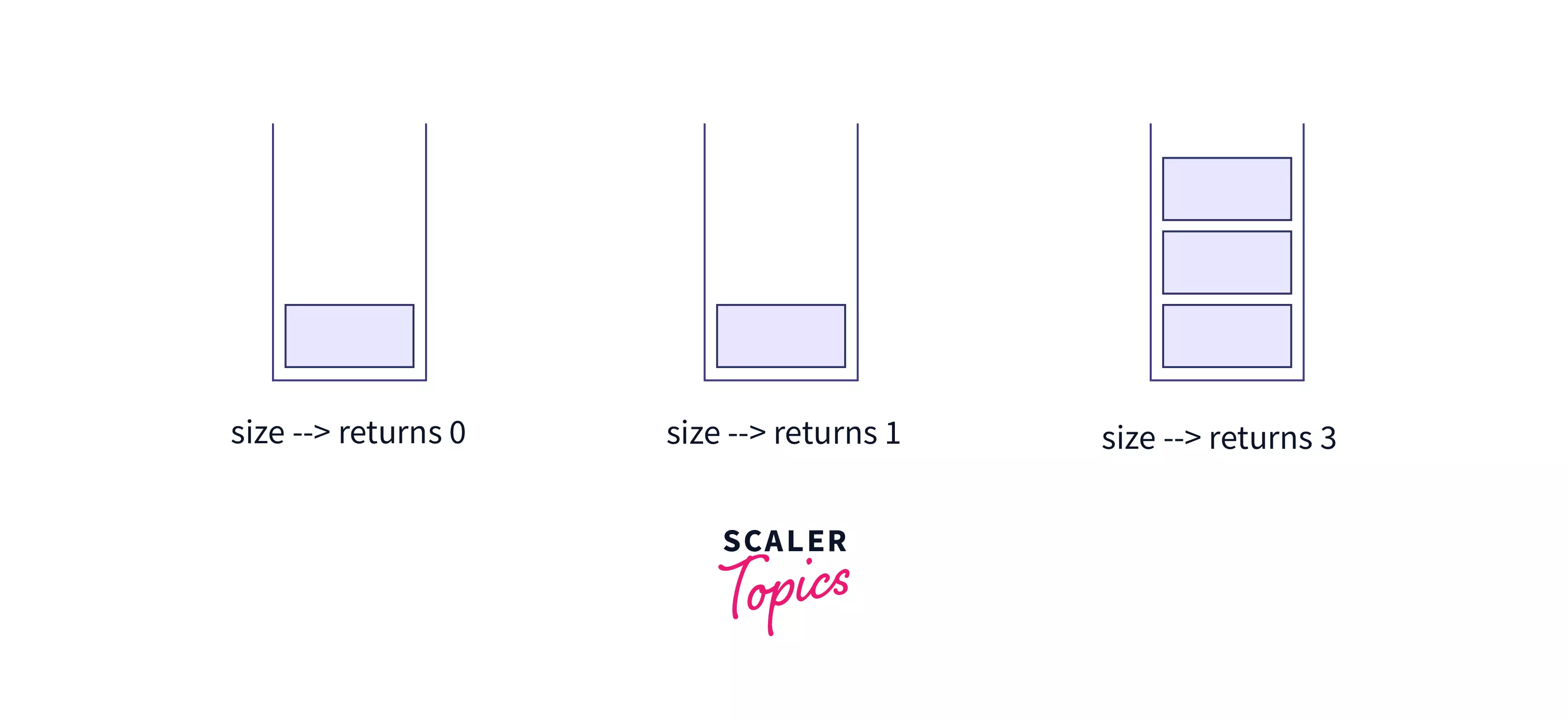
Given below is the syntax of the size function in stack.
#include<bits/stdc++.h>
using namespace std;
int main(){
stack<int> s; // creating a stack of integers
cout<<s.size()<<endl; // Prints 0 since the stack is empty
s.push(1); // This pushes 1 to the stack top
s.push(2); // This pushes 2 to the stack top
cout<<s.size()<<endl; // Prints 2 since the stack contains two elements
s.push(3); // This pushes 3 to the stack top
cout<<s.size()<<endl; // Prints 3 since the stack contains three elements
}
Conclusion
- A stack is a data structure which is used to store data in a linear fashion.
- Stack follows a Last in, First out (LIFO) principle i.e. the data which is inserted most recently in the stack will be deleted first from the stack.
- There are many stack operations that can be performed on a stack. Some of them are push(), pop(), peek(), isEmpty(), isFull(), size().
Become a master of data structures with our Data Structures in C++ Course. Start your journey today!